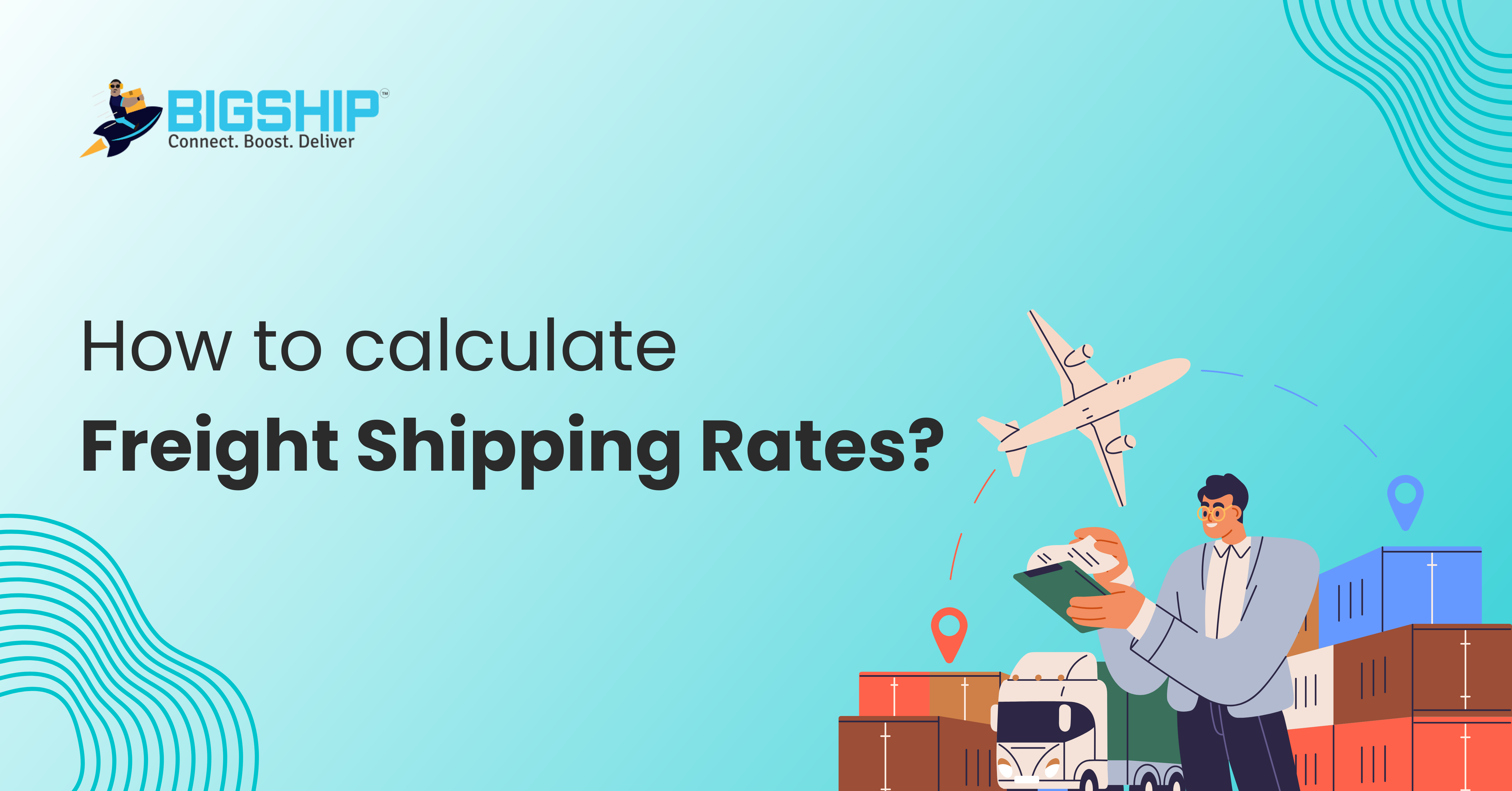How To Calculate Freight Charges: A Complete Guide

Contents:
2. Why Calculate Freight Charges is Important?
3. Factors that Compute Freight Charge
4. Types of Freight Charges
5. Types of Ocean Freight Charges
5.1 Freight Category Charges
5.2 FOB category charges
5.3 DDU category charges
6. Types of Air Freight Charges
7. Types of Truck Freight Charges
8. Methods to Reduce Freight Rate
9. Conclusion
10. FAQs
Freight charges play an important role in determining the overall cost of shipping goods, making it essential for businesses to understand and manage them effectively. In this guide, we’ll explore the various factors that influence freight charges, such as dimensions, origin, destination, and type of commodity.
Additionally, we’ll delve into the different types of freight charges, including ocean, air, and truck freight charges, and discuss methods to reduce shipping costs and optimize freight rates. By the end of the blog, you will also learn how to gain profits by reducing freight costs.
What is a Freight Charge?
Freight refers to the transporting of cargo through different modes of shipping and the charge that is implied on it is known to be the freight charge. These modes of shipping are-
- Seaways
- Airways
- Roadways
A freight charge in simple terms is basically the fee for the transportation of goods from the pick location to the destination which is paid to the carrier. This freight rate will vary from where the goods have to be dropped during the time of delivery, it could be a domestic or international delivery location.
Why Calculate Freight Charges is Important?
Calculating freight charges is important because it helps businesses understand shipping costs, plan their budgets, and avoid unexpected charges. Accurate freight charge calculation ensures that companies can set competitive prices, maintain profitability, and provide transparent costs to their customers by making the shipping process smoother and more efficient.
Factors that Compute Freight Charge
For most businesses, freight rates are crucial for calculating the unit cost of their products. To help you better understand how freight rates work, let’s examine some of the essential factors that shape the price mechanism:
Dimensions of Freight
It is essential to have accurate details of the freight regarding its size, weight, and type of goods because it is one of the main factors determining freight rates. An exact measurement needs to be calculated as it will also calculate the space needed for the goods to be loaded into the truck or whichever mode of transportation is implied for a particular shipment. This measurement is important to know if special handling or spacing is required.
Origin Point and Destination
While determining the freight cost, it is important to see the distance between the origin point and its destination. The distance will decide whether the rate will rise or remain moderate. The higher the distance, the higher the price, and vice-versa. Through zip codes, one can determine the freight charges and by this, the operations will correspond to labor, fuel, and other costs.
Density of Freight
The density of the shipment is used to measure freight classification. Two of the classifications are:
- Full truck load: one shipment is loaded from the point of origin to the final destination. No extra shipment is added to the truck.
- Half truckload: More than one shipments are also loaded to the same transportation.
Freight rates are determined by the freight class and weight.
Types of commodity
The most common and important factor that determines the freight charges is the nature of the commodity. If the commodity is perishable, fragile, or solid in nature then shipping methods are arranged accordingly. If the goods are of higher quality then measures will be taken accordingly and will affect the freight rate.
Economic Factors
The economy is another challenging factor that decides freight rates. The fluctuation in the economy has a huge impact on freight shipping charges. For example, any changes in fuel prices directly affect the freight rates. Seasonal demand for transportation services throughout the year significantly impacts freight rates.
Types of Freight Charges
There are broadly three types of freight charges depending on the mode of transportation. These are ocean freight charges, air freight charges, and truck freight charges. Let’s discuss each type in detail.
Types of Ocean Freight Charges
Ocean freight charges are divided into three main categories: freight category charges, free on board (FOB), and delivery duty unpaid (DDU).
Freight Category Charges
Ocean freight (OCE): This is the basic cost of shipping a container from one location to another.
Bunker adjustment factor (BAF): This surcharge compensates for fluctuations in fuel prices.
Currency adjustment factor: This surcharge applies when paying for cargo in a foreign currency and is usually a percentage of the basic ocean freight.
Interim fuel participation (IFP): This charge is applied by shipping companies in response to fuel price increases.
Origin fuel surcharge (OFUE): This charge, determined by the source country’s oil prices, typically constitutes a percentage of the basic freight cost.
Origin terminal handling charges (OTHC): This fee is levied at the port of origin or terminal for handling containers prior to their loading onto a vessel.
Congestion surcharge (CON): In certain ports, delays of incoming and outgoing vessels occur. Shipping companies apply this freight charge to compensate for congestion.
Emergency risk surcharge (ERS): Shipping companies levy this charge for managing cargo on routes vulnerable to violence or piracy. ERS encompasses bunker costs, insurance, and expenses for implementing extra security measures.
Heavy Lift (HEA): It is an extra surcharge is applied when the cargo exceeds standard weight limits.
FOB category charges
Collection fee (COL): This covers the expense of collecting and delivering goods from the origin to the destination.
Customs entry (CUS): Each country enforces customs procedures for incoming foreign goods.
Cargo data declaration (CDD): This fee is imposed by the European Union to address potential security and safety concerns.
Demurrage charges (DEM): The shipping company incurs this fee if they do not load or unload the ship within the specified time.
Load, lash, and secure (LLS): This fee compensates professionals for loading and securing cargo services.
DDU category charges
Destination fuel surcharge (DFUE): This charge is applied by the destination country, and calculated according to oil prices.
High cube additional (HQA): This fee applies when utilizing a taller high cube container instead of a standard one.
Container cleaning fee (CCF): This charge covers the cleaning of a container if it does not meet standards upon return by the customer.
Container fumigation fee: This charge is incurred before pickup, onboard a ship, or at the port. It encompasses fumigation and de-fumigation costs for cargo and may involve a fuel surcharge.
Chassis fee (CHF): This is an extra charge for utilizing a chassis during overland transportation.
Wharfage (WHA): This fee, levied by port authorities, covers the use of the port’s wharf.
On carriage (ONC): This charge is imposed for inland movement services following the unloading of a container at the discharge port.
Telex electronic cargo release fee: This fee covers the cost of generating and transmitting electronic documents and messages to ports and government agencies.
Destination charges (DES): This fee is applied at the destination port where the shipper transfers the container to the buyer, consignee, or agent.
Types of Air Freight Charges
Air freight charges typically depend on the weight and volume of the shipment. Below are some common air freight charges.
Fuel surcharge (FSC): This fee accounts for regional and seasonal fluctuations in fuel prices.
Security surcharge (SSC): This mandatory fee is imposed by service providers at both origin and destination airports to cover the cost of additional security measures.
Container service charge (CSC): Also known as terminal handling charges, this fee applies when the airport stores cargo in its terminal for a certain period.
Customs clearance fees: These charges are paid by shippers to the customs authorities to permit the entry of goods into a country.
Associated trucking fees: These fees are paid to a trucking company for picking up cargo from an airport and transporting it to the next stage of its journey.
Airport screening fee: This fee is charged by both the departure and arrival airports to conduct screenings for hazardous, dangerous, or prohibited items in the shipment.
Document creation fee: This charge includes the creation of documents such as the bill of lading and delivery order at the origin or destination airports during export or import.
Transport document amendment fee (AMF): The air freight company imposes an AMF on the seller for altering consignor details or cargo information to make the required modifications.
Gateway transfer fee: When a customer requests to transfer the shipment to a third party, such as an agent, broker, or new consignee, the shipping company imposes this fee.
Messenger fee: This charge pertains to courier services for dispatching documents from an airport to a broker, transportation provider, or any partner within the supply chain.
Cargo insurance: This compulsory fee is paid by sellers or consignors to ensure the shipment against loss, damage, or theft.
Types of Truck Freight Charges
Truck freight rates: Freight companies establish these primary rates according to the demand and availability of trucks. Rates may be higher on popular routes and lower in areas with less demand.
Pick-up charges: Freight companies typically collect the consignment from the shipper, encompassing expenses like fuel, loading, and labor costs which is called pick-up charges.
Handling charges: When a customer delivers their consignment to the shipper, sorting and arranging it based on route and urgency may incur these fees.
Main leg charges: These encompass the actual transportation costs, covering expenses such as route fees, fuel, tolls, and applicable regional taxes.
Delivery charges: These charges cover the unloading, sorting, and handling of the shipment prior to delivery.
Methods to Reduce Freight Rate
Freight rate determines the overall profitability of any business and calculating this becomes challenging at times. Here are some methods by which a business can keep shipping costs low.
- Keep easy access to pickup and drop location.
- Minimize space by using the right way of packaging.
- Measure the dimensions accurately of goods.
- Simplify the shipping solutions.
Optimizing certain ways from where the freight cost can be lowered will enable future profits. A business should try to use new ways and search for the aspects that will help in cutting down the cost.
Conclusion
Freight rate calculation is crucial for businesses to save costs and maximize profits by securing the lowest shipping rates. With an accurate freight calculation, a business can make a strong place in the market and adapt to its dynamic changes without any complexities.
Whether it’s ocean, air, or truck freight, knowing the various types of charges enables businesses to make informed decisions and negotiate better rates. By implementing strategies to reduce freight costs and streamline operations, businesses can enhance their competitiveness in the market and achieve long-term success in the shipping industry.
FAQs:
Ques: What is ‘all-inclusive’ rate?
Ans: All Inclusive or All-in rate is the total cost that is associated with the particular shipment from the origin to the final destination, except surcharges.
Ques: What are the major types of freight transportation?
Ans: There are 3 major types of transportation that most shippers offer:-
- Groundways
- Seaways
- Airways
Ques: Why is it necessary to charge a freight rate based on weight?
Ans: To ensure accuracy and avoid unnecessary charges. That is why the freight charge is based on the shipment density.
Ques: How do you calculate the freight charges?
Ans: Freight charges are based on many factors by which they are calculated:
- The distance from the point of origin to the destination.
- Density and dimensions of the shipment
- Economic fluctuation impacting market rates
- Mode of transportation
Ques: Who is liable to pay freight charges?
Ans: In Delivered-at-Place (DAP) the seller has to pay for everything except the import charges.
In Free On Board which includes FOB Origin and FOB Destination where-
- FOB Origin, transportation charges will be paid by the buyer from the seller’s location to the final destination.
- In FOB Destination, the seller covers the cost until the goods reach at buyer’s location.
Ques: What is GST on freight charges?
Ans: GST applies to the freight charges as it is considered a supply of service. That means it is payable by transport company. The current rate for interstate and intrastate freight charges is 5%.
Ques: Is there any difference between freight and transport?
Ans: Freight refers to the process of goods being moved. This movement involves services like loading unloading and delivery.
Transport refers to the movement of goods from place to place through various means like trucks, planes, or other public services.





